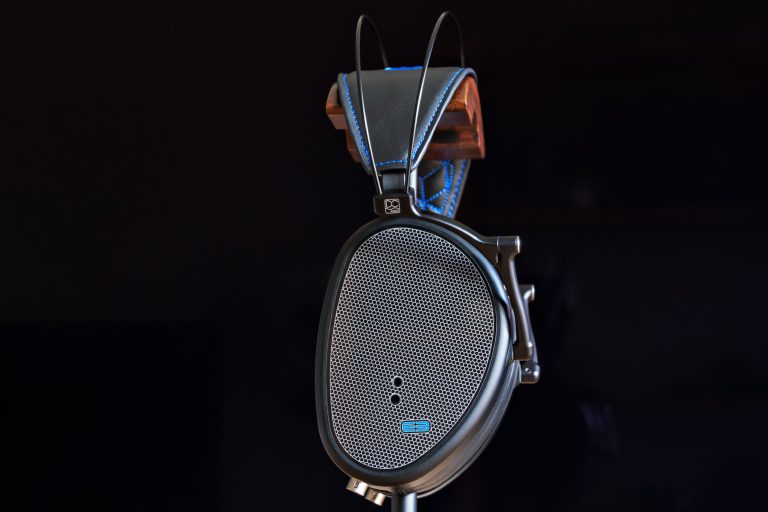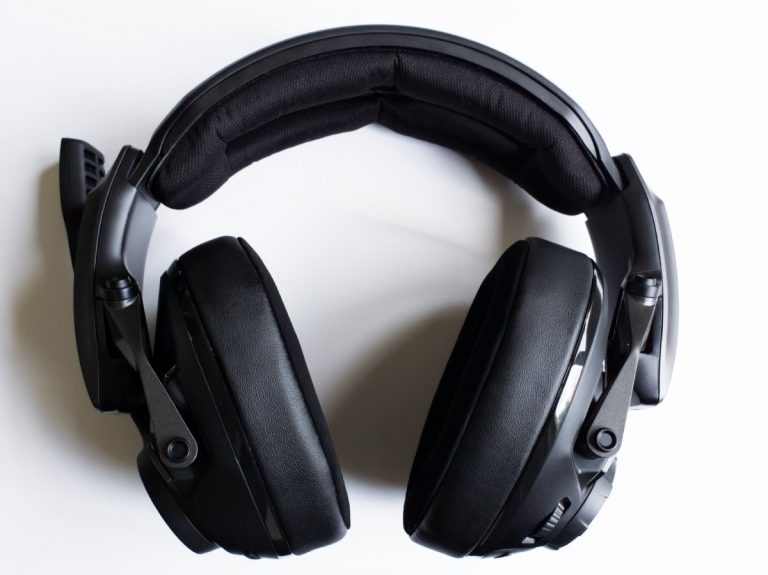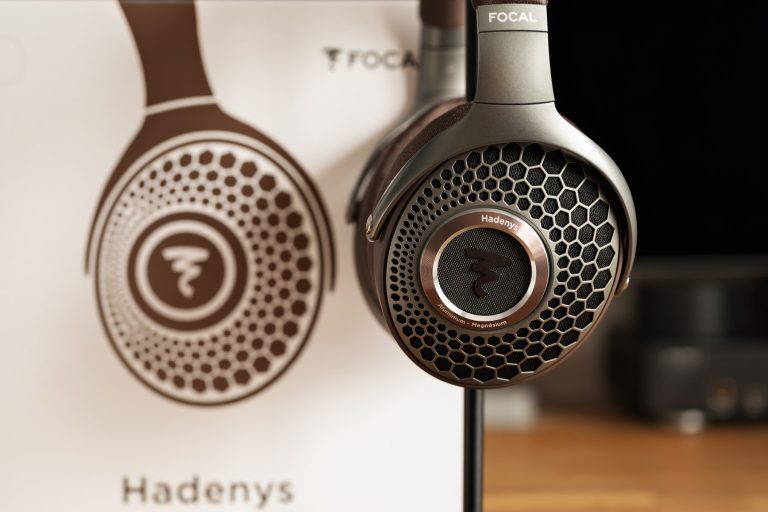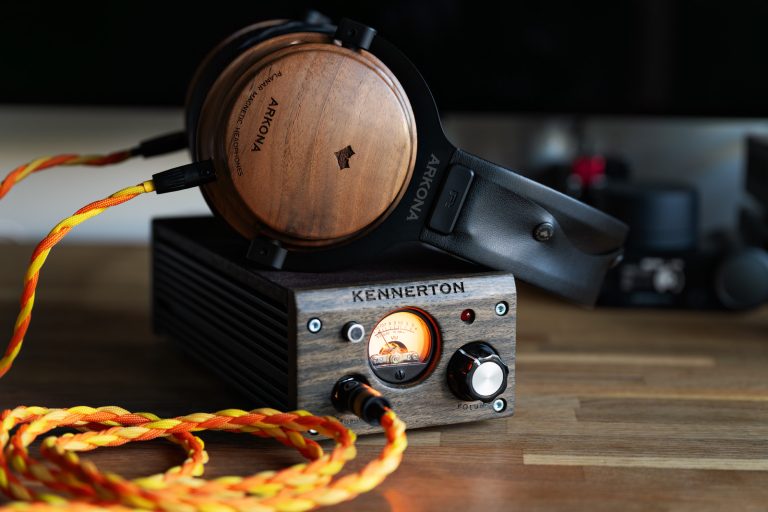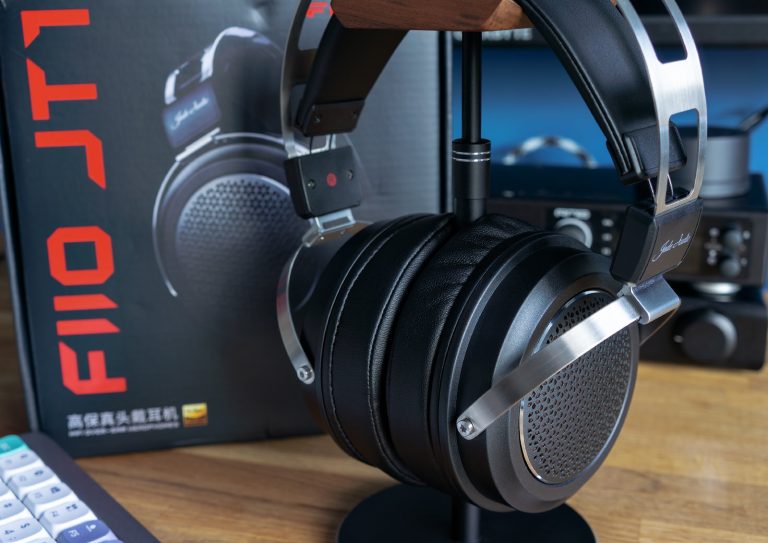SONY WF-1000xm5 Review. It was nice until it wasn’t
The TWS headphones are difficult to make.
Few can make them any good. The Moondrop couldn’t, and the Noble couldn’t, too. The thing is that the manufacturer must think not only about the sound, but also about the software, its stability and user-friendliness. This is why the WF-1000xm4 always were and still are an excellent model for me: the Sony managed to match some good sound, rich feature range, excellent ergonomics and software stability. And then Linkbuds S were released: ‘they’re the same picture’, though much cheaper. These are great, really the best TWS headphones to date, which I honestly stated.
Did I expect much from the WF-1000xm5 (hereinafter referred to as XM5)? Heck yes, I did!

As you may have guessed, today we’re talking about what Sony’s managed to produce.
While working on this review, the following software versions were used.
- 3.0.1 as the headphone firmware version
- 10.2.0 as the headphone Android app
1. What’s included
The headphones came in a tiny cardboard box. It doesn’t look or feel premium at all, I wouldn’t even give it a chance to store the headphones between usages: after you remove the adhesive strip, the lower and the upper parts of the box don’t stick together.
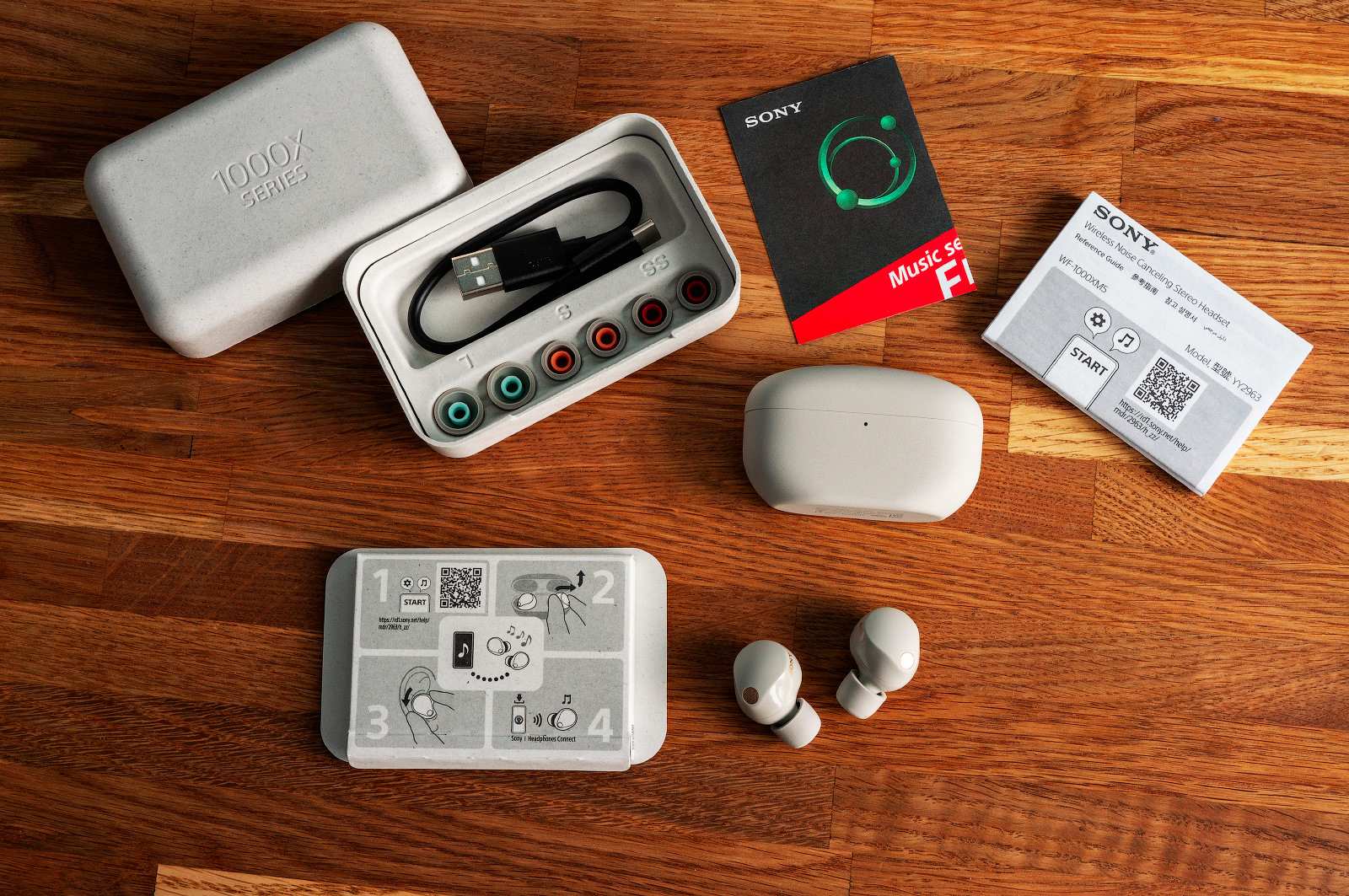
So, the set is as follows.
- The headphones.
- A charging case.
- A tiny USB-A to USB Type-C cable.
- 4 pairs of composite silicone foam eartips.
- Some papers.
2. Hardware and software
Key features:
- sensors for detecting the headphones in your ears, and they work fine. You can set the playback auto-pausing when you take the headphones out, as well as the playback auto-resume when the headphones are back in your head;
- Speak-to-chat feature: this one automatically interrupts playback and turns on acoustic transparency mode when you start a conversation. A some kind of sensor detects you saying something via bone conduction. Any sniffing with your mouth closed, sneezing and other sounds unlike speech wouldn’t trigger the feature. But say a single word – and here it is;
- simultaneous connection to two devices. Using the LDAC codec for both devices, how do you like it!
- active noise reduction with 3 microphones in each earpiece to do the job. It’s actually excellent, if not the best among currently available in different models right now;
- acoustic transparency mode with a separate setting to highlight the voices from the general noise.
Additional features:
- equalizer with 5 bands + bass tuning, as well as a step-by-step sound adjustment to your liking;
- auto-turn off of the headphones to save battery;
- voice notifications volume setting;
- control gesture setting. Kinda basic;
- wireless charging of the case;
- Spotify support.
Useless features:
- tracking head gestures: you can accept calls with a nod, and reject them with a shake. I know you suffered a lot before this fantastic thing was invented. Like, a lot;
- earpieces fit check to pick the right eartips;
- voice assistant support: of any assistant you use on your device;
- DSEE Extreme proprietary sound enhancer. You just buckle up with this monster;
- 360 Reality Audio spatial sound support;
- head position tracking calibration to optimize the spatial sound functioning (the Spatial Sound standard first appeared for Android 13);
- headphone usage stats collecting. With achievements;
- noise reduction mode auto-switching depending on the user’s location and the detected activity;
- Endel support.
As you can see, the headphones are full of functions! And I like it.
But if you take a look at a bigger picture, these aren’t any different from the previous model, which raises some questions. Well, they can say if my head dodders, and it’s a priceless feature for sure, but something else as a difference would be much appreciated, to put it mildly. Say, what if you could connect the case to your PC via USB cable and use that case as a Bluetooth transmitter? Amazingly useful when the PC doesn’t sport a Bluetooth adapter (which is very common, I’d say). I want a parametric equalizer, I want a translation tool. I want some ultraviolet inside the case for earpiece disinfection. Where’s the NFC, after all?
3. Design, assembly, technology
The manufacturer states a new dynamic driver with the marketing name Dynamic Driver X is used here, though says nothing about what it’s made of or what design features it has. Pity. There are 3 mics in each earpiece (with one of those inside the sound duct) for the active noise reduction.

From the point of view of algorithm, the noise reduction is based on AI (new fashion, y’all). To detect user’s speech, bone conduction sensors are used. How many sensors there are to capture the voice during a conversation? Unknown.
As for the assembly: everything is done and assembled properly – this is hands down premium (or even Premium).

The halves of the earpiece enclosure are precisely fitted to each other.

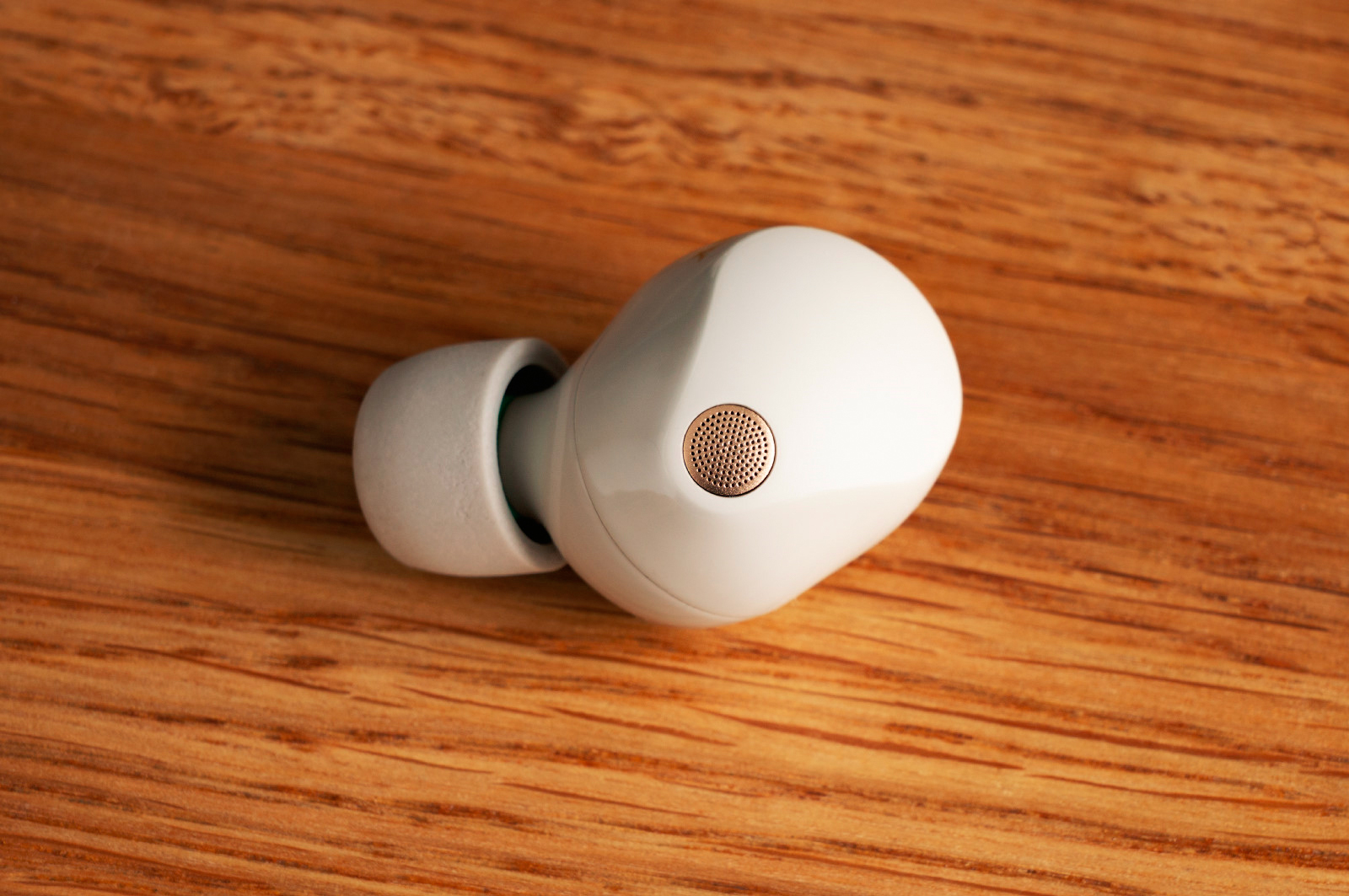
The case doesn’t creak when opened. The lid is just a little bit loose, but we’re talking about, like, half a millimeter here. And the earpieces jump into the case slots thanks to magnets.
4. Ergonomics, usage experience
I’ll begin with failish stuff.
- The headphones have glossy slippery enclosures, which is why it’s sometimes difficult to take them out of their case. Not too handy when you try to adjust them in your ears, too.
- The whole set of the provided eartips is made of foam siliconish material (don’t even know what’s it called). They have flanges like silicone eartips, but the material is clearly some dense foam. Just so you know, not everyone likes foam eartips, but there’s no alternative in the set.
- The earpiece shape makes it impossible to shove them any more or less deep inside the ears. By deep I mean something like with the 1000xm4 or the LinkBuds S, not even mentioning the etymotic ER2. In my case, this only makes me permanently feel like the earpieces are going to pop off my ears. Moreover, the XM5 are the first in-ear headphones I’ve owned or tried to echo my own footsteps into my ears. This happens in 90% of usage cases, and there only was a couple of times I’ve managed to fit them in a way to avoid such an effect. Fun fact: when I do manage to fit them as I’ve just mentioned, the enclosures bulge and stick out of the ears. This calls for a green version to cosplay Shrek.
- When the LDAC is on, the connection drastically lacks stability: sound in only one ear, interruptions out of the blue, etc. Well, it feels like it’s about the headphones themselves, since I’ve tested the 1000xm4 and the Linkbuds S with flagship smartphones from the same manufacturer (S21U and S23U) lying in the same pocket of the same jacket, on the same path to the same job – the testing conditions weren’t any different. The 1000xm4 and the Linkbuds S didn’t even try to pull the same tricks on me. With the XM5, the connection can be interrupted suddenly while watching videos at home with the smartphone being just 30-40 cm away from the headphones. This can be fixed by changing the LDAC settings to ‘Balanced’ in the ‘Developer Options’ on Android. However, should I really look for such workarounds when the XM5 cost as much as they do? I don’t think so.
- The control gesture settings are kinda rudimentary: there are only 2 presets for the left and the right earpieces to choose from. Don’t even think about separate gesture setup. At the same time, the manufacturer suggests adjusting the volume with four (!) taps, and this can’t be changed in any way. Look at me walking down the street punching myself in the ear. ‘Fight Club’, audiophiliac edition. Sony, how exactly did you come up with this idea?
- And the well-known glitch of the Sony’s latest TWS headphones didn’t go anywhere, when 99% of the volume is in the right earpiece, and 1% is in the left one. Got it once with the XM5. This can be easily fixed by putting both earpieces in the case and then taking them out again, but I sill feel a bit fooled.
Now to the wins!
- The proprietary Headphones app is still smart and bug-free. And works stably. No problems with connection, or voice detection, or equalizer, or anything else. All settings are stored on the headphone side, by the way. As before, the firmware update takes forever!
- The case is small, about the same size as for the Linkbuds S. It also has a textured matte surface and a button for forced pairing. It’s convenient to carry in your pocket and use.
- It accurately recognizes any gestures, and you actually can adjust the earpiece fit in your ear without triggering any of the many XM5 features.
Given all the above, let’s just rate the ergonomics as objectively controversial and subjectively disgusting. The rest is obviously about software problems: both the internal headphone firmware and the app (in terms operation with the LDAC mode, when the headphones just won’t work as they should).
No Christmas presents for you this year, Sony.
5. Quick specifications overview
- Design: in-ear closed-back.
- Drivers: one 8,4-mm dynamic driver.
- Weight of a single earpiece: 5,9 grams.
- Weight of the case with the headphones inside: 39 grams.
- Bluetooth version: 5.3.
- Dust and moisture protection: IPX4.
- Audio transmission protocols: SBC, AAC, LC3, LDAC.
- Headphone battery life*: 8 hours with active noise reduction (but without using equalizer and DSEE) on a single charge.
- Case charging time: 2 hours.
* In reality – about 6 hours at 60-80% volume, without DSEE, but using LDAC, equalizer and ANC.
6. Subjective sound impression
I’ve been testing these headphones for about 40 hours with the Galaxy S23 Ultra (LDAC) smartphone, Galaxy S22 (LDAC), as well as the Hiby R5 (LDAC) player as sound sources.
In its original, non-equalized form, the XM5 sound is just some Sony classics. It has a booming subbass, a humming bass, and an emphasis in the 4–7 kHz range. The resulting sound is rather foggy and prickly, which I personally find quite difficult to enjoy.
And, as always with TWS headphones, I recommend equalization. Let’s get to the XM5 sound after some adjustments (for equalizer parameters, see section 10).
The subbass gets back to its norm relative to the rest of the frequencies, it feels ‘fast’ and can pound (if necessary). It’s very ‘deep’ thanks to good eartip sound insulation.
The mid-frequency range clicks into place, gets natural, expressive and clear.
The upper frequencies quit scratching on your eardrums. The headphones sound pleasantly, very close to neutral. The sounding gets versatile and, I’d say, suits most musical genres (with an expressive bass, nevertheless).
It’s worth noting that the XM5 sound more voluminous compared to other TWS headphones, and the instruments can be localized more clearly. I can’t perceive some INCREDIBLE sound stage here, but it’s still very good.
As for me, the XM5 are among the best TWS headphones, but, of course, after some equalization.
7. Sound source choice
I couldn’t hear any difference when testing the XM5 with different sound sources I used (Galaxy S23 Ultra (LDAC), Galaxy S22 (LDAC), Hiby R5 (LDAC)).
8. Eartip choice
I’ve tried my entire eartip collection, and the winner is the Whizzer SS20. These are the eartips with rounded shape that allows the XM5 with their not too deep uncomfortable fit to stay more or less securely in my ears.
The sound duct diameter and length of the Whizzer SS20 coincide with those of the XM4, so they really fit. And I’ve also kindly enumerated the list of all the same-ish models at the end of this review.
9. Measurements
The headphones were used with the Hiby R5 player (LDAC). A measuring rig conforms to the IEC60318-4 standard. The smoothing is indicated on the graphs. I’ve described the limitations of the rig and the headphones measurements in general in this article.
Here’s the XM5 frequency response with the LDAC codec and without ANC, that is, their original sound out of the box:
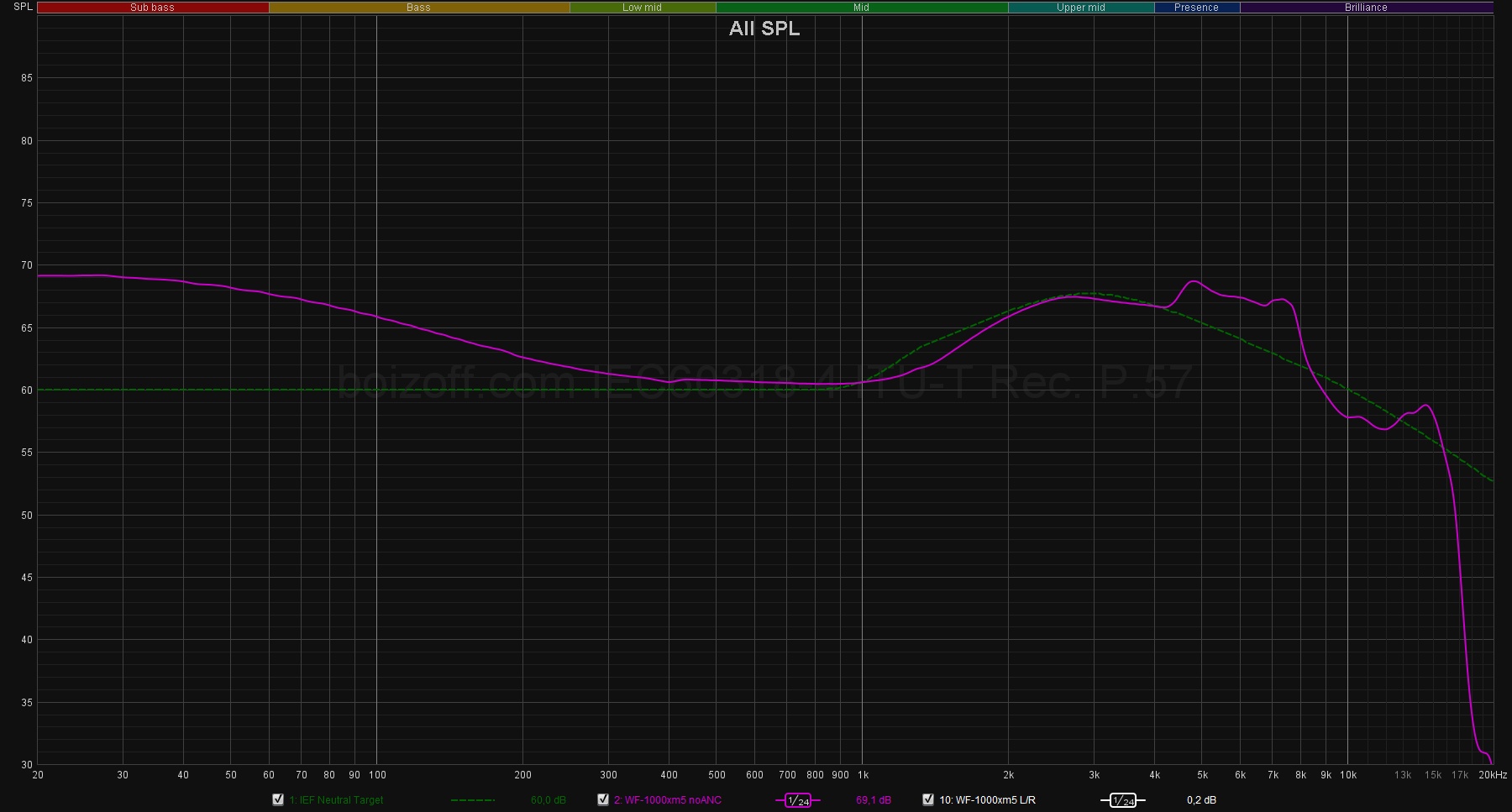
Now let’s turn on the active noise reduction — no changes in tuning, and this is very good.
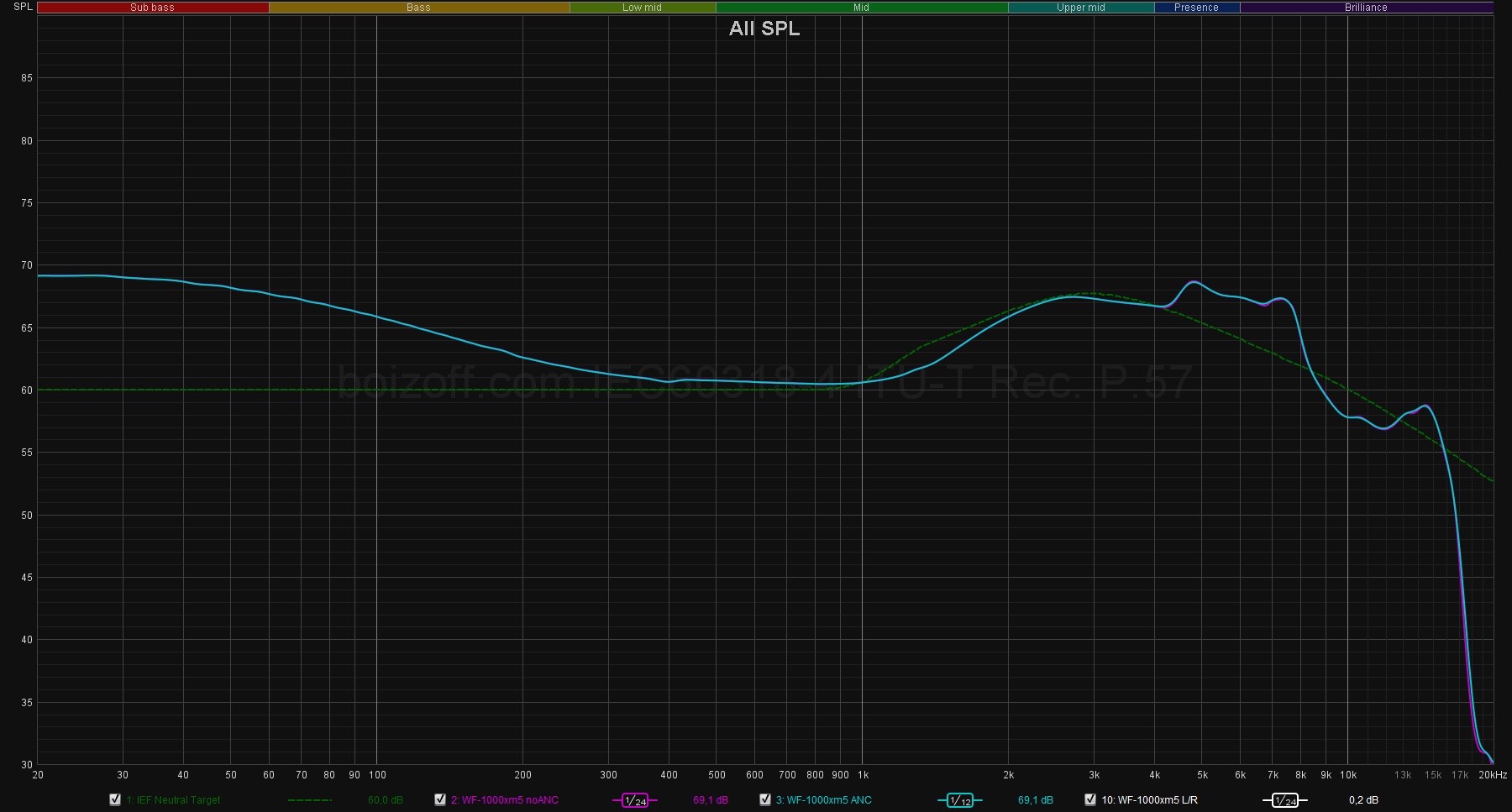
Let’s turn on the DSEE Extreme, and again the curves match.
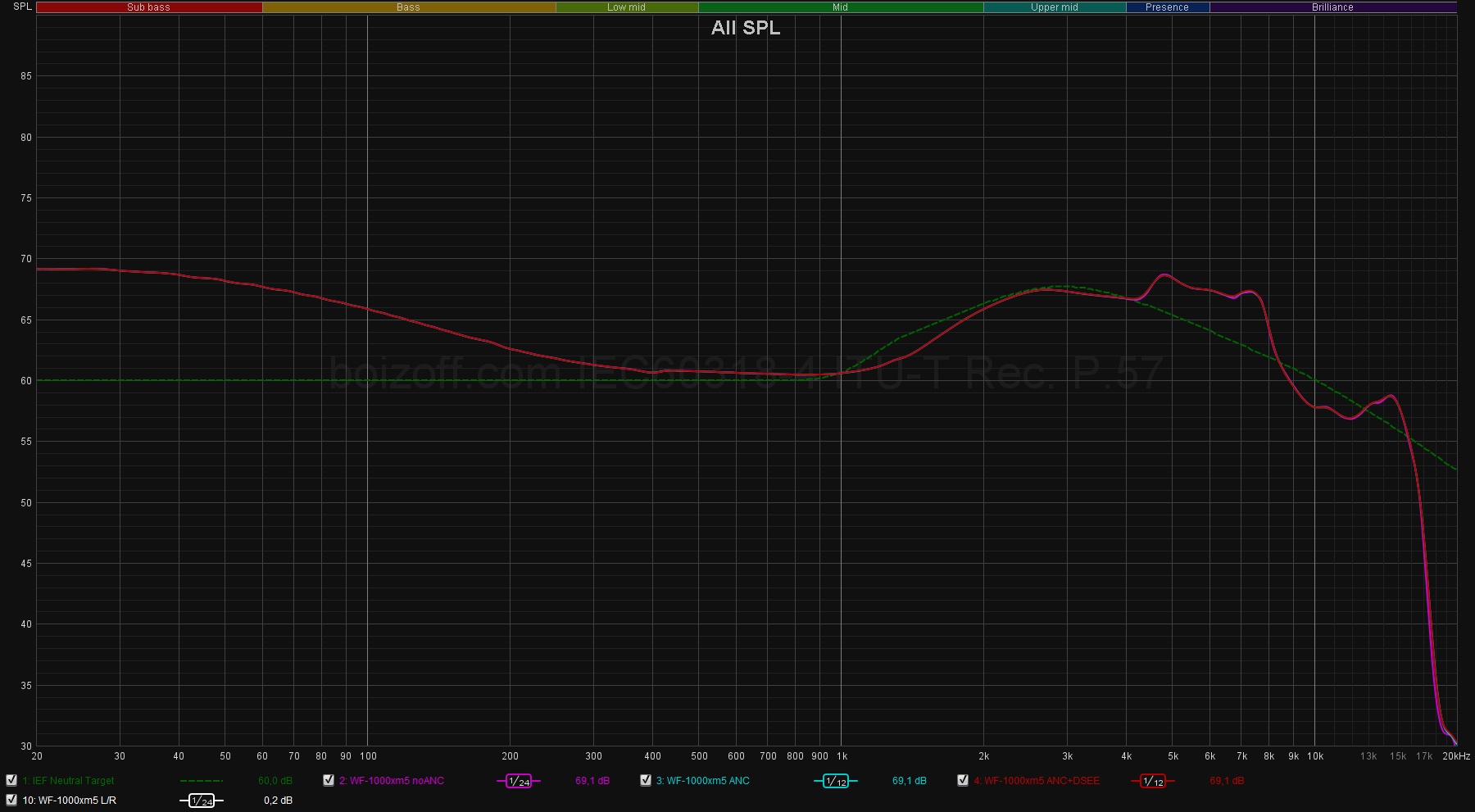
Now to the fit depth: the differences are everywhere – from 3 to 17 kHz.
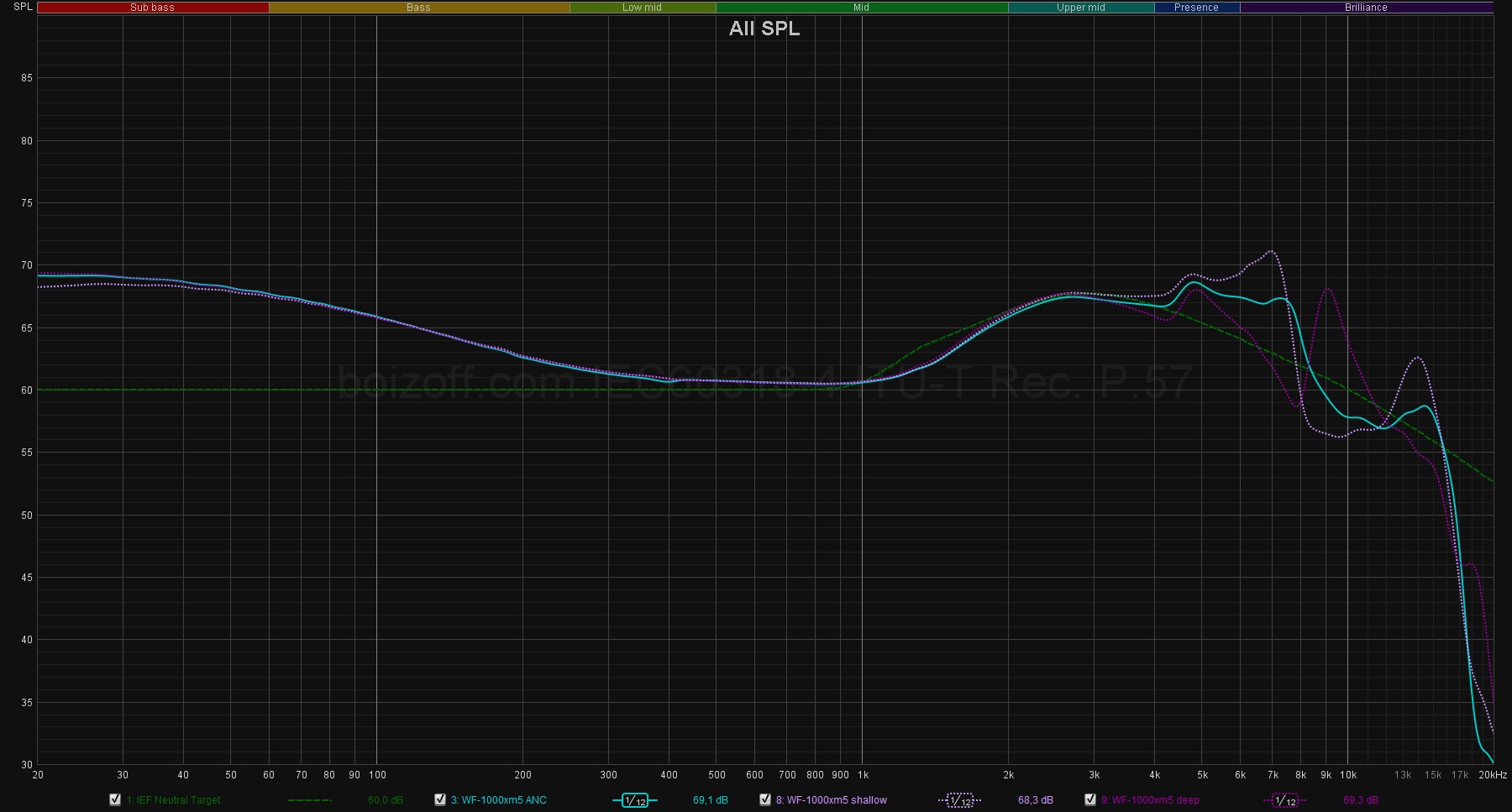
The sound equivalence of the left and right channels: the channels are perfectly aligned.
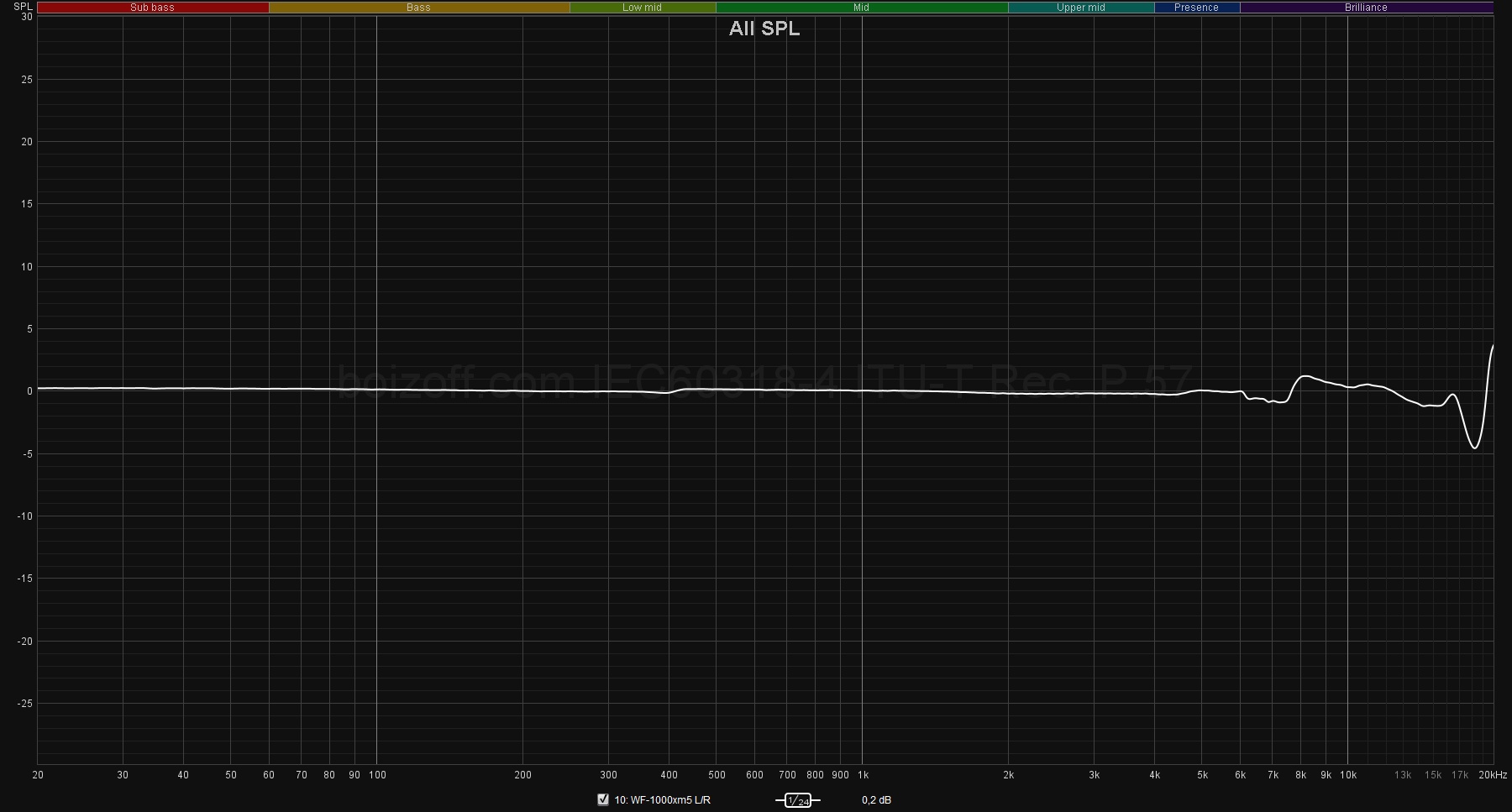
Distortion at 80% volume: not a bad result for TWS headphones!
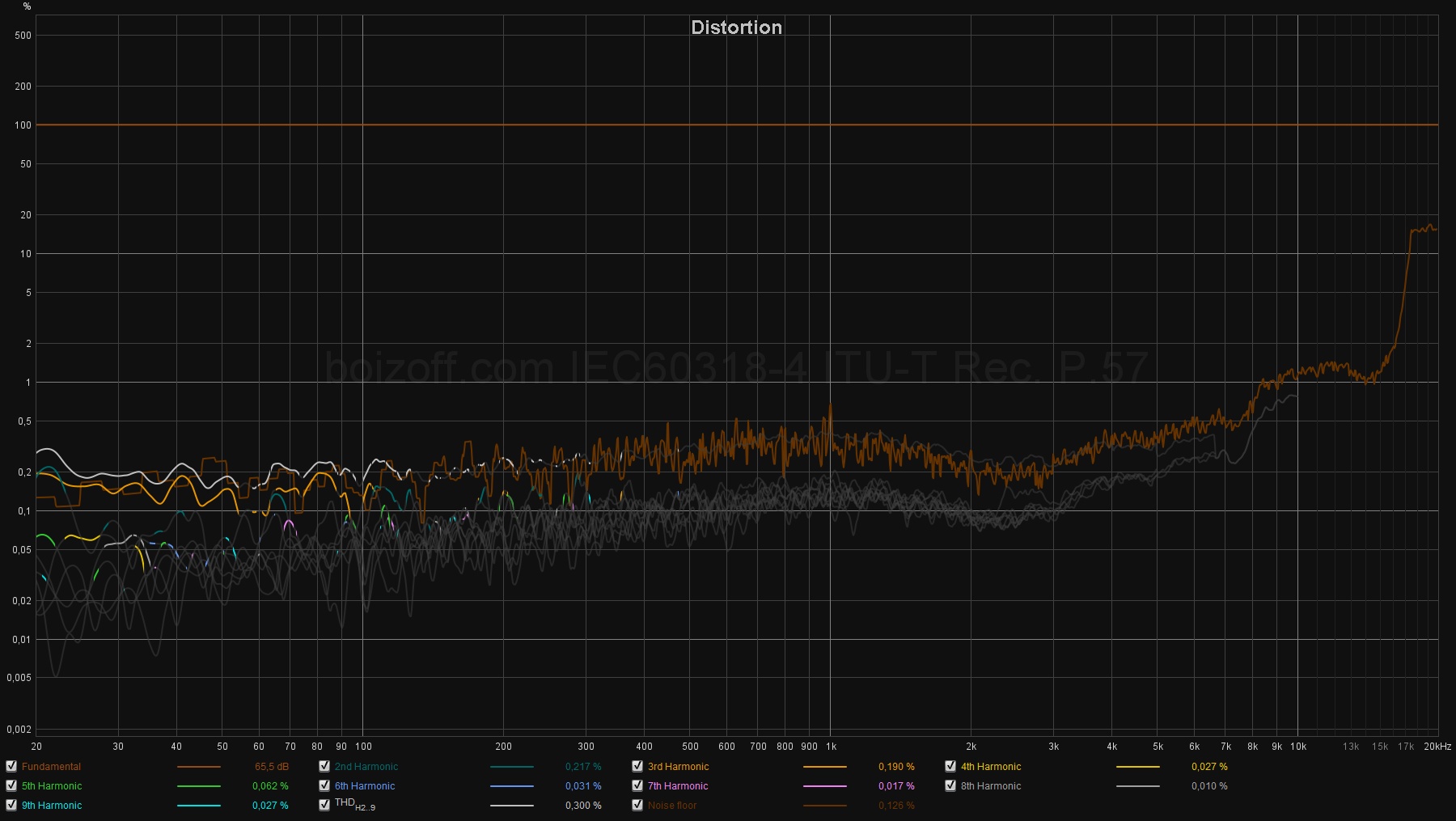
10. Equalization tips
First, let’s take a look at how the Clear BASS tuning works. So, what’s the reason of those smooth raises and lowerings at the beginning of the frequency response graph? Could it be any filter like LowShelf? Nah, the bass curves at +10 dB and -10 dB look… interesting:
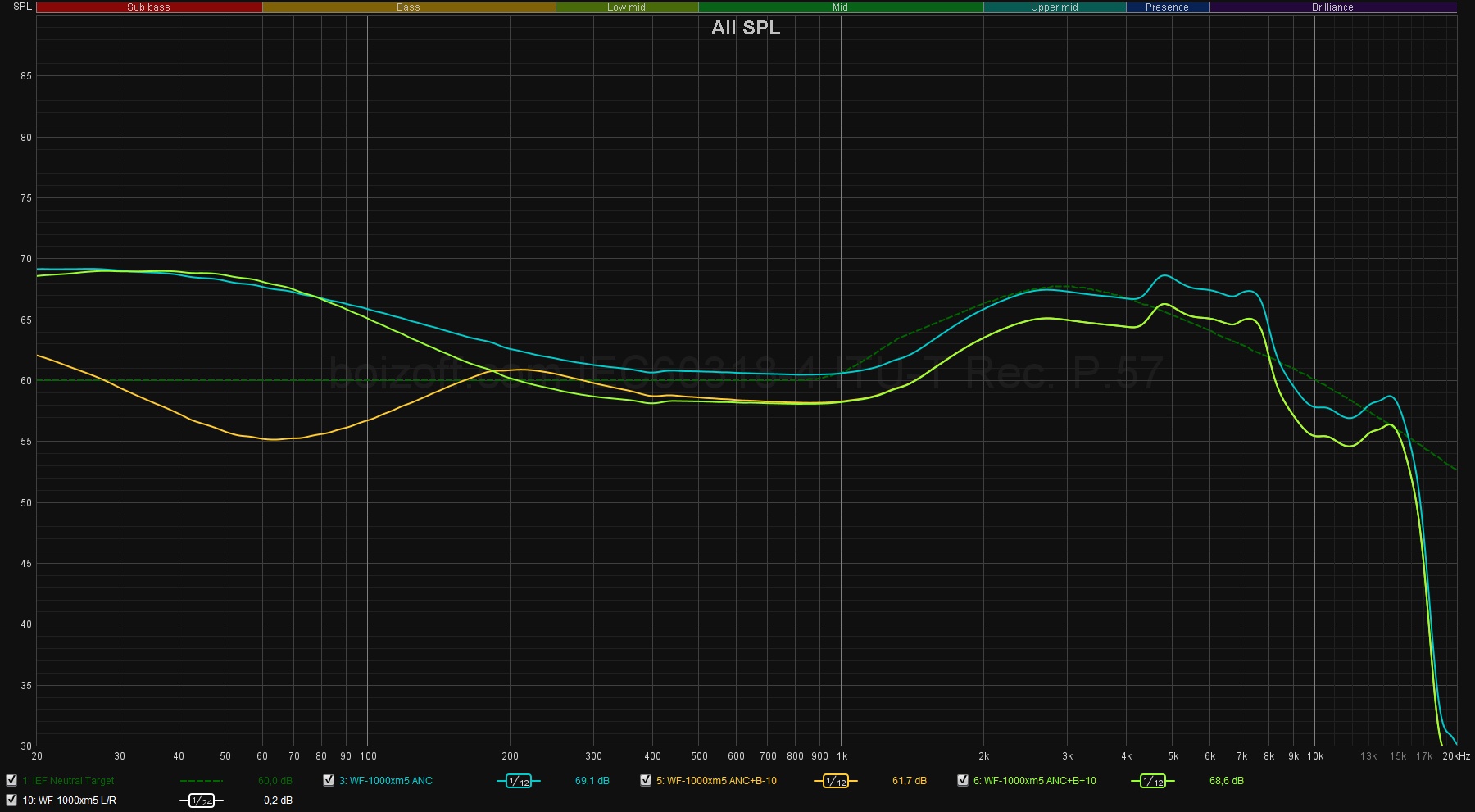
At the same time, the headphones lower the volume to prevent sound distortion, even if you take the bass down.
How do we bring the XM5 sound to some kind of norm? Here you go:
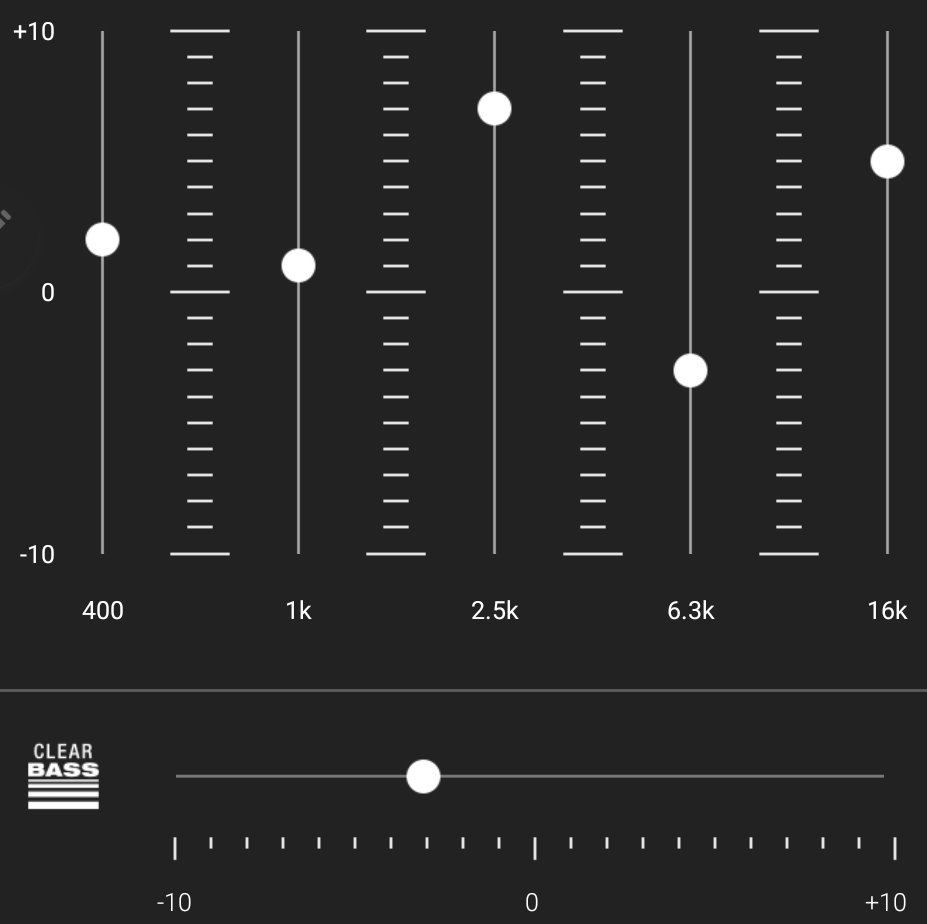
And the frequency response becomes somewhat acceptable:

I know what you might be thinking, but there’s really no way you could bring the XM5 sound any closer to Harman’s funky tuning using a standard equalizer.
11. Comparisons
11.2. XM5 vs XM4

The fit. Subjectively, the XM5 fit a lot worse. Take a close look at the photo: both sit on the Blu Tack and are aligned in the same plane:

As you can see, the XM5 sound duct is designed at a completely different angle compared to the XM4, and that’s why the XM5 stick out of (my) ears as an ear trumpet. Also mind the hump at the base of the XM5 sound duct, which is much larger, so they just can’t be shoved in your auditory canal, but hang on the eartip at the very opening.
The XM5 and XM4 frequency responses compared – with active noise reduction enabled, when using LDAC and after equalization:
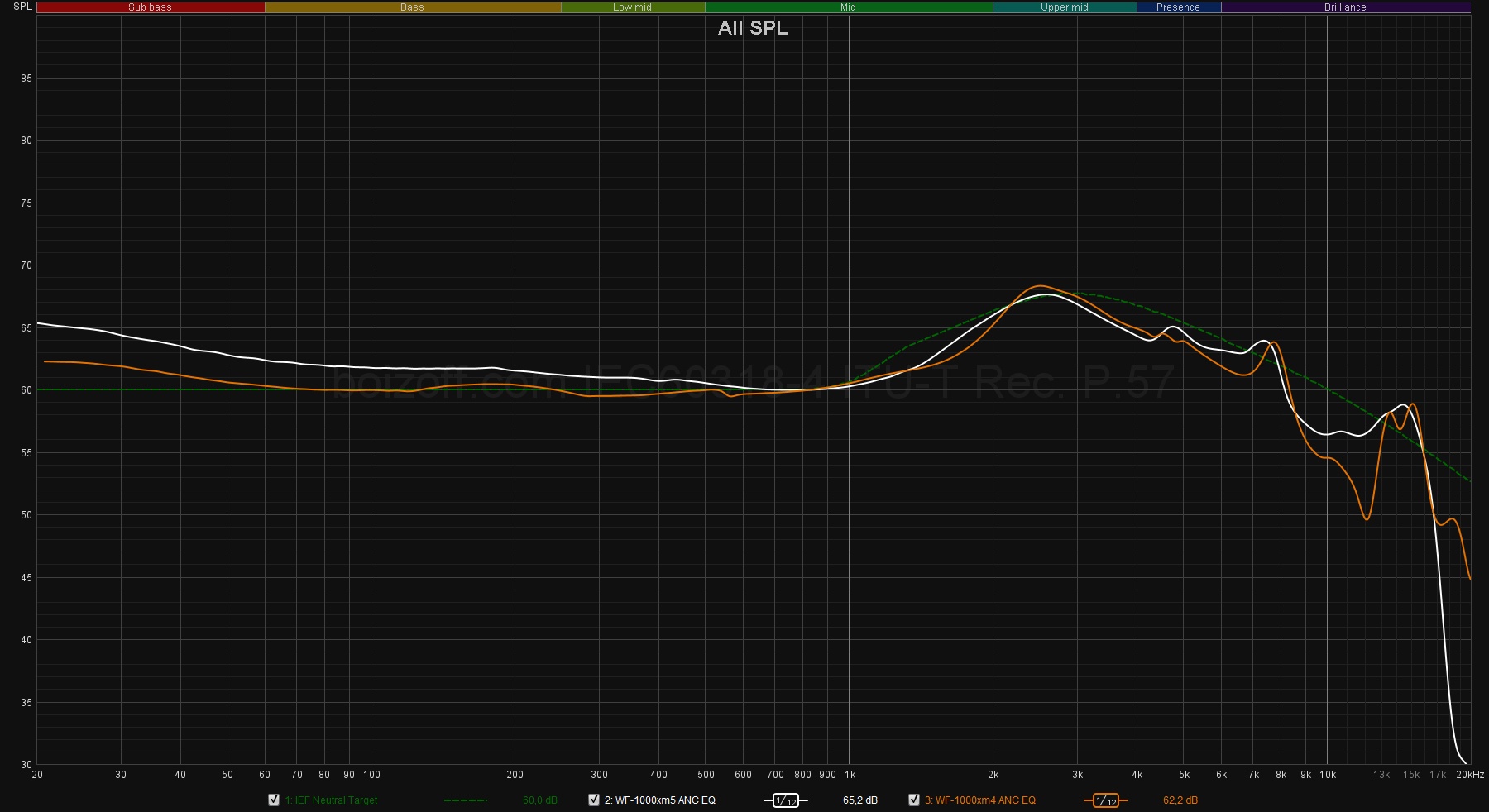
The XM4 has that dip at the 12 kHz, but their overall tuning can be taken to a much more neutral one – look at the bass and subbass.
Other significant differences: the XM5 detect your head gestures, the XM5 have significantly better mics, the XM5 have a smaller case, and the XM5 are twice as expensive.
11.2. XM5 vs Linkbuds S

Objectively, in terms of fit versatility, the Linkbuds S outperform almost any TWS headphones. Subjectively, the Linkbuds S are a lot better in terms of fit comfort than XM5.
The XM5 and Linkbuds S frequency responses compared – with active noise reduction enabled, when using LDAC and after equalization:
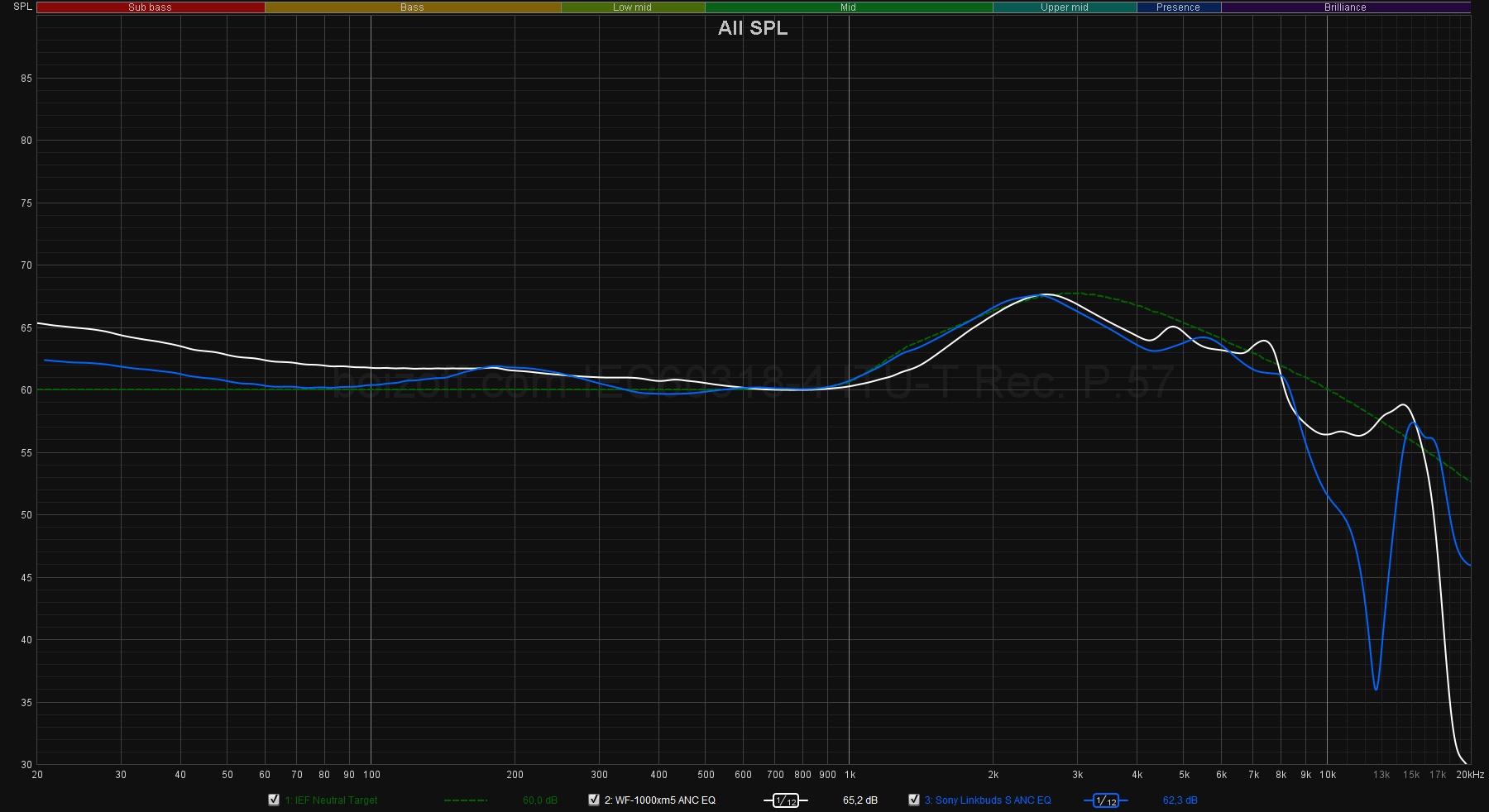
The Linkbuds S have a dip at the 12.5 kHz, but it gets slightly better around 1.2 kHz, and you can easily tune them more neutral.
Other significant differences: the XM5 detect your head gestures, the XM5 have wireless charging, the XM5 have slightly better mics, and the XM5 are twice as expensive.
12. Summary
I only have two things to complain about in the WF-1000xm5.
The first follows from my expectations: I can’t really see any progress in this. The acoustic design is the same, though there could be reinforcement or MEMS drivers added, for example; I don’t see any new functionalities, I don’t see any significant superiority in sound over the 1000xm4 and the Linkbuds S models, especially after equalization and at half the cost of these two.
And the second one is that Sony kinda messed up what was previously done well. The ergonomics (which is an extremely important point for TWS headphones) isn’t any good. The excellent textured surface of the black Linkbuds S is now glossy and all slippery, the sound duct tilt and the enclosure shape were changed, so that I can’t even shove the earpieces any deep into my ears.
Sony, please tell us what happened?
As such, I don’t think the WF-1000xm5 are worth buying, especially when the Linkbuds S are available on the market. This wouldn’t be the case if the only thing you’ve been missing in headphones for years is head shaking detection.
…Does anybody need the Sony WF-1000xm5? Slightly used, excellent condition.
P.S. Have your WF-1000xm4 batteries died? Click here, if you want some answers.

